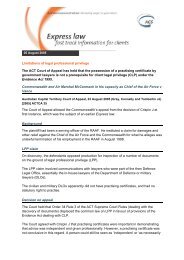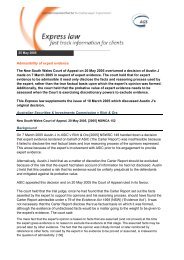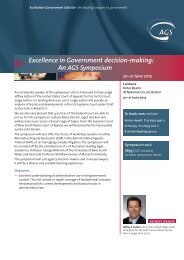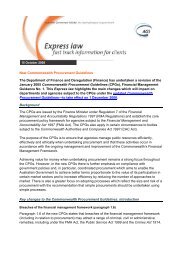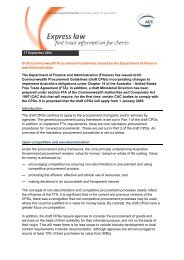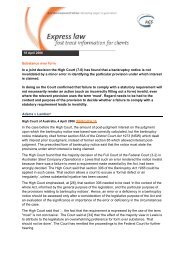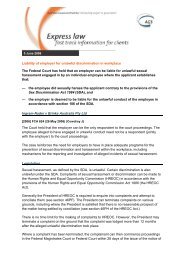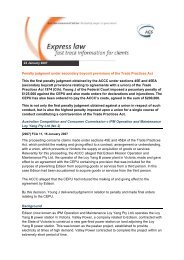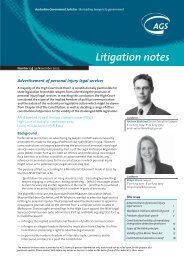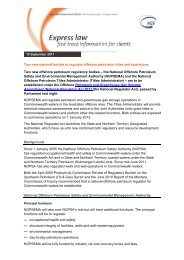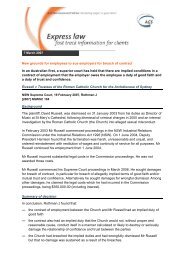annual report 2012 â 13 - Australian Government Solicitor
annual report 2012 â 13 - Australian Government Solicitor
annual report 2012 â 13 - Australian Government Solicitor
You also want an ePaper? Increase the reach of your titles
YUMPU automatically turns print PDFs into web optimized ePapers that Google loves.
NOTES TO AND FORMING PART OF THE FINANCIAL STATEMENTSfor the year ended 30 June 20<strong>13</strong>The leave liabilities are calculated on the basis ofemployees’ remuneration at the estimated salary ratesthat will apply at the time the leave is taken, includingAGS’s employer superannuation contribution rates tothe extent that the leave is likely to be taken duringservice rather than paid out on termination.The liability for long service leave has been determinedby reference to the shorthand method prescribed in theFMOs as at 30 June 20<strong>13</strong>. The estimate of the presentvalue of the liability takes into account attrition ratesand pay increases through promotion and inflation.Separation and RedundancyProvision is made for separation and redundancypayments. AGS recognises a provision for terminationwhen it has developed a detailed formal plan for theterminations and has informed those employeesaffected that it will carry out the terminations.Provision for separation and redundancy was of$906 000 made at 30 June 20<strong>13</strong> ($1 146 000 in <strong>2012</strong>).SuperannuationEmployees of AGS are members of the CommonwealthSuperannuation Scheme (CSS), the Public SectorSuperannuation Scheme (PSS), or to a schemedetermined by the employee, or in default of nominationby the employee, a scheme nominated by AGS.The CSS and PSS are defined benefit schemes for the<strong>Australian</strong> <strong>Government</strong>. Other super schemes aredefined contribution schemes.The liability for defined benefits is recognised in thefinancial statements of the <strong>Australian</strong> <strong>Government</strong> andis settled by the <strong>Australian</strong> <strong>Government</strong> in due course.This liability is <strong>report</strong>ed by the Department of Financeand Deregulation’s administered schedule and notes.AGS makes employer contributions to the employeesuperannuation schemes of:• The <strong>Australian</strong> <strong>Government</strong>, at rates determined byan actuary to be sufficient to meet the current cost tothe <strong>Government</strong>. AGS accounts for the contributionsas if they were contributions to defined contributionplans• non <strong>Australian</strong> <strong>Government</strong> funds, as determinedby the current AGS certified agreement.The liability for superannuation recognised as at30 June represents outstanding contributions for thefinal fortnight of the year.1.9 LeasesA distinction is made between finance leases andoperating leases. Finance leases effectively transfer fromthe lessor to the lessee substantially all the risks andrewards incidental to ownership of leased non-currentassets. An operating lease is a lease that is not a financelease. In operating leases, the lessor effectively retainssubstantially all such risks and benefits.Where an asset is acquired by means of a finance lease,the asset is capitalised at either the fair value of thelease property or, if lower, the present value of minimumlease payments at the inception of the contract and aliability recognised at the same time and for the sameamount.The discount rate used is the interest rate implicit inthe lease. Leased assets are amortised over the periodof the lease. Lease payments are allocated betweenthe principal component and the interest expense.Operating lease payments are expensed on a straight linebasis which is representative of the pattern of benefitsderived from the leased assets.Lease incentives taking the form of ‘free’ leaseholdimprovements and rent holidays are recognised asliabilities. These liabilities are reduced by allocating leasepayments between rental expense and reduction of theliability.1.10 Borrowing costsAll borrowing costs are expensed as incurred. During theyear AGS had no loans.1.11 CashCash is recognised at its nominal amounts.Cash and cash equivalents includes:• cash on hand• demand deposits in bank accounts with an originalmaturity of 3 months or less that are readily convertibleto known amounts of cash and subject to insignificantrisk of changes in value.Cash and cash equivalents exclude investments undersection 19 of the Commonwealth Authorities andCompanies Act 1997.1.12 Financial assetsAGS classifies its financial assets in the followingcategories:• held-to-maturity investments• loans and receivables.The classification depends on the nature and purposeof the financial assets and is determined at the time ofinitial recognition.Financial assets are recognised and derecognised upontrade date.Effective interest methodThe effective interest method is a method of calculatingthe amortised cost of a financial asset and of allocatinginterest income over the relevant period. The effectiveinterest rate is the rate that exactly discounts estimatedfuture cash receipts through the expected life of thefinancial asset, or, where appropriate, a shorter period.Income is recognised on an effective interest rate basisexcept for financial assets that are recognised at fair valuethrough profit or loss.Held-to-maturity investmentsNon-derivative financial assets with fixed or determinablepayments and fixed maturity dates that AGS has thepositive intent and ability to hold to maturity areAGS Annual <strong>report</strong> <strong>2012</strong>–<strong>13</strong> 67



